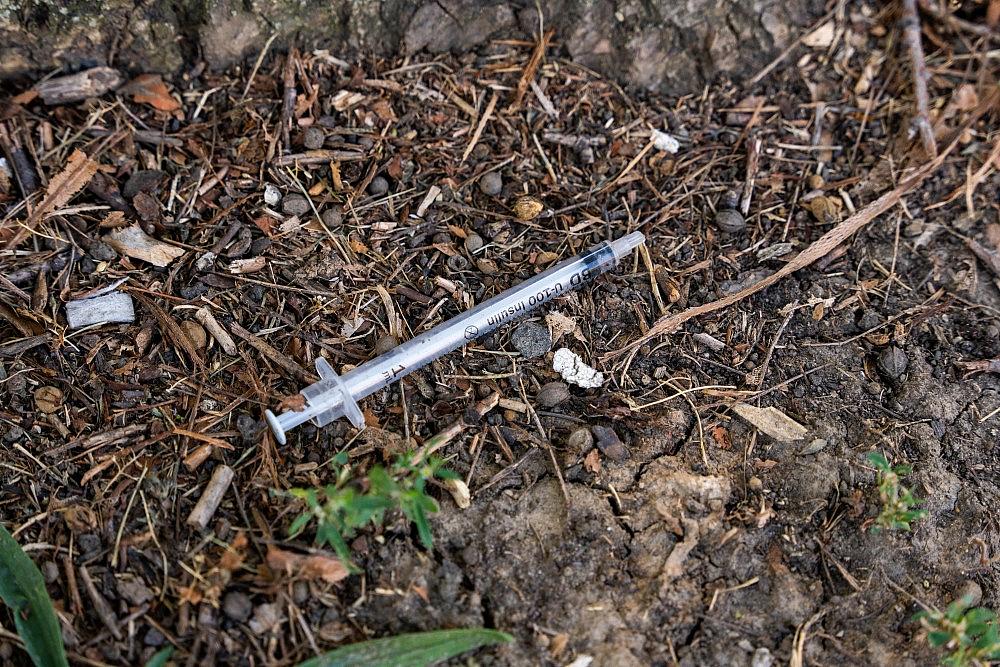Dead-End Drug Arrests: How We Reported This Story
This was produced as part of larger story package for the USC Center for Health Journalism's 2021 National Fellowship.
Other stories include:
Kim Foxx’s ex-trainer caught up in ‘unending cycle’ of drug arrests; ‘It breaks my heart’ by Frank Main, Jared Rutecki and Casey Toner
The costly toll of dead-end drug arrests — a Sun-Times / BGA special report by Frank Main, Jared Rutecki and Casey Toner
Oregon’s the first state to ticket narcotics users, but reform has yet to live up to what was promised by Frank Main, Jared Rutecki and Casey Toner
New Illinois law gives cops choice not to jail people for small amounts of drugs — a follow-up to our ‘Costly toll of dead-end drug arrests’ investigation by Frank Main, Jared Rutecki and Casey Toner

A used needle on the ground in Garfield Park in an area known for heroin use.
(Brian Ernst/Sun-Times)
To compile this report, the Better Government Association and Chicago Sun-Times analyzed 280,000 total drug possession arrests made in Cook County between 2000 and 2018. The data used was provided by The Circuit, a collaborative of news organizations, including the BGA and Injustice Watch, that spent years obtaining, analyzing and standardizing Cook County Circuit Court data for all criminal court cases.
The data provided includes the name, age, race, arrest date, jurisdiction and information from the court docket, which includes hearing dates and case disposition.
To determine how, over time, Cook County and Chicago have treated those charged with low-level drug offenses, the examination focused on only the cases in which the top charge filed against individuals was possession of less than 15 grams of a controlled substance — the lowest-felony drug charge in Illinois.
Because court data available does not provide some of the information needed for the analysis, such as the precise amount of drugs less than 15 grams, reporters took a random sample of 365 cases from the most recent year in our study — 2018 — so that they could examine the available paper records at the courthouse. The clerk of the Cook County Circuit Court doesn’t make scanned files of all years available at court terminals, but files from recent years, including 2018, are available. This allowed reporters to collect police reports, charging documents and other records that provided much deeper detail. Cases involving marijuana charges were not considered, as those charges are treated differently under Illinois law.
Cases were classified as advancing to the criminal phase or dismissed.
Of the 365 cases pulled, there were 227 where the highest quantity was 1 gram or less.
Our findings from this sample were then applied to all narcotics possession cases in 2018, with a confidence interval of 95% and a standard error of plus or minus 1.4%. Based on this analysis, the estimated dismissal rate for all narcotics possession cases of 1 gram or less in 2018 increased to greater than 95%.
The broader data analysis determined the dismissal rate from all examined cases for 2018 — including cases where the weight was higher than 1 gram — was 71.8%, and 50% for 2000 to 2018. The rate of dismissal increased through the years.
A confidence interval defines the probability that another sample using the same method would return a similar result if tested again. Standard error shows how much the sample differs from the whole population.
The analysis also examined Chicago Police Department arrest data for 2014 to 2021, the most recent data available. This allowed reporters to understand the geography of drug cases more clearly than was possible from the court data.
In an effort to put a price tag on these dead-end drug arrests, data was requested from the Cook County Sheriff’s Office to determine how long those arrested between 2013 and 2018 were incarcerated, as well as the daily cost.
Figures for the daily cost of incarceration per person provided by the Cook County sheriff’s office. The estimates were made by the Cook County Office of Research, Operations and Innovation. These estimates include typical salary, food and uniform costs but do not include the cost of medical care or other common treatments for people brought to jail with addiction-related health issues.
The analysis was performed using PostgreSQL and various R packages, including ggmap and sf. Spatial analysis and maps were created using geocoded data from the CPD as well as shape files of police beats, police districts and streets.
Data analysis by Jared Rutecki, Casey Toner, Forest Gregg and Hannah Cushman Garland.
Additional reporting by Frank Main and Analisa Trofimuk.
Read more about the methodology of The Circuit project here, and about the process used for the charges, race, ethnicity and gender data here.
This series is a collaboration between the Chicago Sun-Times and the Better Government Association.
Reporters: Frank Main (CST), Jared Rutecki (BGA), Casey Toner (BGA)
Data Analysis: Hannah Cushman (DataMade), Forest Gregg (DataMade), Casey Toner (BGA), Jared Rutecki (BGA)
Contributors: Analisa Trofimuk (BGA)
Photographers/Video: Pat Nabong (CST), Ashley Rezin (CST), Joe Kline (CST)
Engagement/Social: Nina Fuentes (BGA), Olivia Obineme (BGA), Alyssa Billmeyer (CST), Brianna Peoples (CST), Satchel Price (CST)
Web/Graphics: Cesar Calderon (BGA), Jesse Howe (CST), Andy Boyle (CST)
Editors: David Kidwell (BGA), John Chase (BGA), Paul Saltzman (CST)
Read all the pieces in this series:
- The Costly Toll of Dead-End Drug Arrests
- Kim Foxx’s Ex-Trainer Caught Up in ‘Unending Cycle’ of Drug Arrests
- Oregon Is First State to Ticket Narcotics Users, but New Reform Has Yet To Live Up To Promise
To support this kind of independent investigative journalism, you can sign up for a Chicago Sun-Times subscription or donate to the Better Government Association.
[This article was originally published by Better Government Association.]

